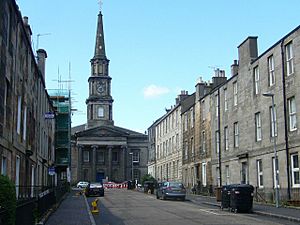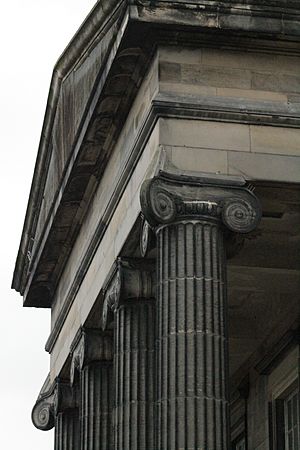North Leith Parish Church facts for kids
North Leith Parish Church was a church in Leith, Scotland. Leith used to be a separate town but became part of Edinburgh in 1920. This church was part of the Church of Scotland. It served the people living in a specific area of Leith.
Contents
The Church Building: A Look Inside and Out
The church building you see today is on Madeira Street in Leith. It was designed by a famous architect named William Burn. The building was finished in 1816. It has a special front entrance called a portico, with four large columns. Above this, there is a clock tower with a tall, thin spire.
In 1880, a large pipe organ was added inside. During World War II, in 1941, the building was damaged by bombs. But it was fixed by 1950. Today, it is a very important historical building, known as a Category A listed building. The church was built to hold about 1300 people.
William Burn also designed other well-known buildings in Edinburgh. These include the Edinburgh Academy and John Watson's College, which is now the Scottish National Gallery of Modern Art.
The minister's house, called the manse, was built in 1825. It was located near the church on Ferry Road. This house and its gardens were later removed in 1920. This space was then used to build the Leith Theatre.
Church History: From Old Chapels to New Unions
The church's story goes way back to 1128. That's when King David I of Scotland gave land for Holyrood Abbey to be built. In 1493, a chapel called St Ninian's Chapel was built on land owned by the Abbey. This small chapel was later rebuilt after the Scottish Reformation.
The new church opened in 1586. It became the main church for the North Leith area. In 1606, the Scottish Parliament made North Leith a full parish, meaning it was important for both church and local government. A Dutch-style tower was added to this old church in 1675.
Later, problems with rot were found in the building. Even after repairs, the church was too small. So, a new, bigger church was built in 1816. This is the building we see today. The old church's Dutch-style tower still stands. It was later used as part of a mill. In the old churchyard, you can find the tomb of Thomas Gladstones. He was a successful merchant and the grandfather of William Ewart Gladstone, who became a famous Prime Minister.
In 1843, many people left the Church of Scotland to form new churches. This event was called the Disruption. About 600 members and all the elders from North Leith left. They built a new church called North Leith Free Church. This church could hold 1000 people. Later, in 1859, an even bigger Free Church was built. This building was taken down in 1981.
Over the years, North Leith Parish Church joined with other churches. In 1968, it united with Bonnington Church. They became Leith North & Bonnington Church. Then, in 1982, this church joined with Leith St Ninian's Ferry Road Church. This created the current congregation, which kept the historic name North Leith Parish Church.
In March 2024, the congregation merged with South Leith Parish Church. They now use the South Leith building. The last regular Sunday service at the Madeira Street building was on March 25, 2024. However, the building is still used for special services, like the Good Friday service.
The Parish Area: What the Church Served
The church's parish covered the north-west part of Leith. This area includes the Fort housing scheme and Leith Docks. It also includes the Ocean Terminal shopping centre, the Royal Yacht Britannia, and the Scottish Government offices at Victoria Quay.
Church Leaders: Ministers Through the Years
Many ministers have served North Leith Parish Church over the centuries. The first Presbyterian minister was appointed in 1598. A house for the minister, called the manse, was built in 1600.
Some of the ministers who served the church include:
- James Murehead (1598–1612)
- David Forrester (1613–1620 and 1627–1633)
- Henry Charteris (1620–1627)
- George Wishart (1638)
- Andrew Fairfoul (1641–1652)
- John Knox (1653–1662)
- James Reid (1663–1671)
- Thomas Wilkie (1672–1682)
- James Hutcheson (1682–1687)
- James Lundie (1687–1696)
- Andrew Bowie (1697–1707)
- John Wilson (1708–1724)
- George Lindsay (1725–1764)
- David Johnston (1765–1824)
- Walter Foggo Ireland (1799–1828)
- James Buchanan (1828–1840)
- Alexander Davidson (1843–1858)
- William Smith (1860–1877)
- Robert Stewart (1877–1881)
- Andrew Wallace Williamson (1882–1883)
- John Hutton McCulloch (1884–1912)
- James Robertson Sweet (1913–1942)
- Hugh Osborne Douglas (1942–1951)
- John Heron Gibson (1952–1959)
- Andrew Stewart Todd (1960–1967)
More recent ministers include:
- Reverend Douglas Clarke (1968–1979)
- Reverend William G. Neill (1980–1986)
- Reverend Alastair G. C. McGregor (1987–2002)
- Reverend Dr Kenneth S. Baird (2003–2009)
- Reverend Alexander McAspurren (2011–2019)
Burial Ground: Resting Places
The first church from 1493 likely used an old burial ground nearby. But this ground was built over in 1656 to create a fortress. A new burial ground was then started on Coburg Street in 1664. When the new church opened on Madeira Street, it didn't have much space for burials. So, families continued to use the Coburg Street Burial Ground.
The Coburg Street burial ground is a bit separate from the old church. Some notable people buried there include:
- Robert Nicoll, a poet.
- Rev David Johnston, a minister of the church.
- Colonel Anne Mackintosh, a female military leader from the Jacobite rebellion.
See also




